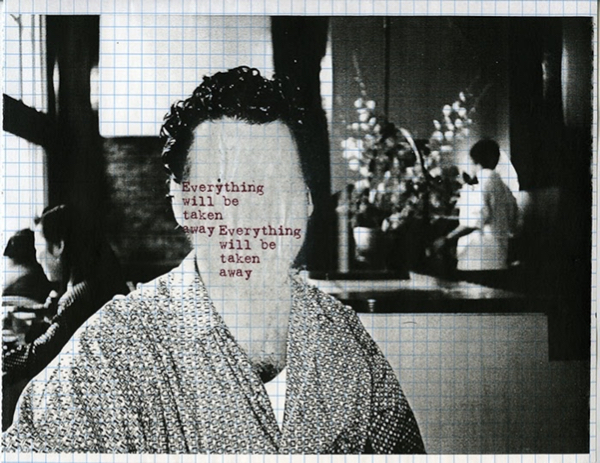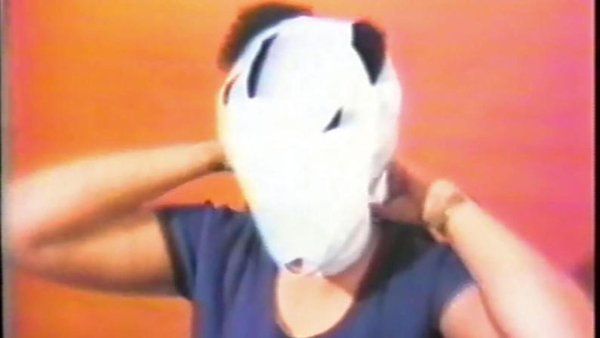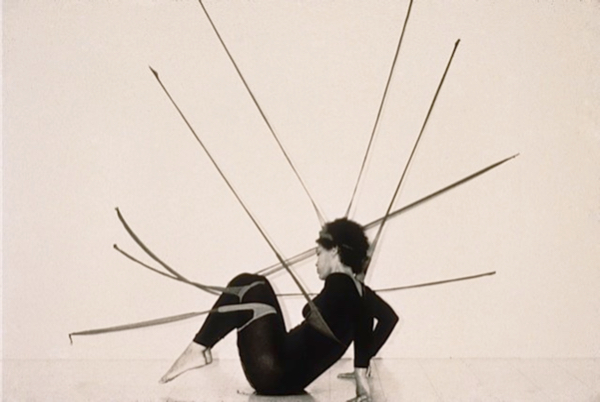Social death on parade
Door Tundé Adefioye, op Tue Aug 30 2022 22:00:00 GMT+0000What is social death and what can potentially lead to it? Could the search for ‘inclusion’ or notoriety (but not yet fame) be detrimental? Instead of offering answers, Tundé Adefioye collects questions and open-ended references, left for the reader to explore. While centering aspects of Blackness, Adefioye mentions persons, events, and quotes that dive deep into the existence of racialized and marginalized people in general. Social death is a dying of the soul, spirit and a recession of mental well-being. Is there an antidote?
What they saw is what they saw
But did they really see what they thought they saw? Maya tried to explain it, distinguished and glorified. Making plain what Paul Laurence had written many years before in We Wear The Mask. Pointing and allowing the seeing, unmasking the then modern-day Black women working low-paid jobs, cleaning houses, wearing masks every day in big cities, ghost(-ed) across different corners of the land.
Ida, Langston, Denzel, Oprah, or even James have spent a lot of their time and energy trying to edify Black culture, traditions and the people that come with it. This is not selling out, this is not Uncle Tom'in, this is about seeing the suffering of one's kin, one's people and attempting to make it visible for dominant white culture in order to…
This death continues to manifest itself in various ways in our current society, where many of us are dying to be seen.
In order to what? In order to find oneself holding on to pennies and mule bones like Zora had to? In order to hold on to the last bits of one's sanity like Nina and then later what Lauryn synchronized to? In order to be taken life like the Kings’ - Martin Luther and then Rodney. No kin, but they suffered from similar pains.
Add Walter, no King but a Rodney, who had ended life prematurely. Being seen eventually killed them. One by a white man's hand, the other by accident, but all pushed to their demise by dominant white society. Martin knew already that being seen could lead to death. Not the physical loss of one's body, as Martin would later experience, but a death of the social kind.

In nineteen sixty-so-and-so, months before the historic march on Washington, Martin's people got a call from the venerable Adam Jr. This to warn Martin, that if Bayard was allowed to speak at the March, there would be rumors spread that Martin and Bayard had an affair. Even suggesting the March on Washington be canceled. More than now, many religious Black folks were very much Chapellin' queer folks and women (queer or not) and relegating them to the back or sidelines.
Martin heeded the warning that would cause Bayard, one of the main organizers of the event, to be pushed way back. A death that would almost wipe Bayard out of that historical moment completely. Important to note that what brought on this moment, was because Bayard was openly gay and, in fact, in 1953, in Pasadena California, was arrested for breaking the State's then sodomy laws. A fact that would later be used by people like Powell to simultaneously attempt to manipulate the course of the Civil Rights Movement while in essence, try and erase Bayard's legacy.
The lessons we forgot about solidarity, is what will eventually lead to our demise. We instead jostle to be seen, and dance to the beat of the white supremacist war drum.
Though this was the case for many years, fortunately, this would not be the end of Bayard’s legacy. Years later, thanks to some astute archivist Bayard's legacy was revived. Nevertheless, at that moment in time, Bayard experienced a type of death that sometimes can be unbearable.
This death continues to manifest itself in various ways in our current society, where many of us are dying to be seen. Many of us survive and flourish in that seeing but some of us experience a social death, that like Bayard forces us to pull back, reassess what is important to us and step out of the light into the warm soothing comfort of the dark.
Grief as a way to remove stars from a night sky
When we can't see far, we think we don't have enough, when all we ever needed was each other. True, Zora told us, ‘all my skinfolk ain’t kin folk’. A descendant of Zora’s critical and trail-blazing gaze, adrienne maree, openly shares in We Will Not Cancel US: And Other Dreams of Transformative Justice (2021):
‘In the past, I have lost my connection to life, to wanting to live, thought it didn’t much matter if I was here or not, and so it didn’t much matter how I treated myself or others. When I was in that phase of ambiguous commitment to life, I took risks with my mind and body that I couldn’t imagine taking now. I practiced cynicism and hopelessness (…). It was a brief phase of my life, but during that time I believed in nothing (…). I have had to choose life from deep within me. That’s why I’m still here. I want to live. I want to want to live. I think everyone chooses each day to move towards life or away from it, though some don’t realize that they are making the choice. Capitalism makes it hard to see your own direction (…). Places with a variety of economies and exposure have found ways to move towards life.’
We get inebriated by it in secret and the public face we show is one of compassion, empathy, and selflessness in trying to liberate our people.
The lessons we forgot about solidarity, is what will eventually lead to our demise. We instead jostle to be seen, and dance to the beat of the white supremacist war drum. All the while, the drum of the Kumeyaay tribe was still beating, helping us to see the way. Reindigenizing, but we don't see that. Being seen by dominant society is violent, but yet it has its allure, luring us to take sips ‘till we have a toxic overdose.
The approval we've been denied for so long is what drives us. Climbing up the hill that we are ready to die on, to hang on the cross that was built by hegemonic power. Power that we still do not acknowledge as the impetus for our action. Truth be told, even when we yelling ‘devil let my people go’, it is about power.

Unless you’re more like Harriet and less like Martin, it is about power. Unless you’re more like Che and less like Castro it is about power. Unless you’re more like Tutu and less like the Mandela’s, it is about power. We get inebriated by it in secret and the public face we show is one of compassion, empathy, and selflessness in trying to liberate our people.
Who is the ‘we’, we speak about anyhow? The homogenized started disembodying long ago, when the vinegar of whiteness was added to our blood to dominate our beings. God-complexed and ready to do what it takes to continue to be seen by white supremacist society as the voice of your people, just like Adam Jr. This is where social death is initiated, followed by being embedded in white culture.
Being seen can lead to social death
At times our social death is more subtle, more like a retreat; a trying to re-member. It does not always have to end with violence or actual death, though that can be part of it, to erase the memory of the peace that once was felt. Retreating into ourselves, sometimes to a point of social isolation, while avoiding all manners of being seen, allows us a re-knowing.
Being seen by dominant society is violent, but yet it has its allure, luring us to take sips ‘till we have a toxic overdose.
Re-knowing is to know what it means to care for ourselves again. Cultivate joy to resurrect from social death, and re-root in communities of solidarity and strength that nourish. Poet and social worker Leah Lakshmi Piepzna-Samarasinha critically wonders in their book Care Work, Dreaming Disability Justice (2018):
‘What does it mean to wrestle with these ideas of softness and strength, vulnerability, pride, asking for help, and not – all of which are so deeply raced and classed and gendered? If collective access is revolutionary love without charity, how do we learn to love each other? How do we learn to do this love work of collective care that lifts us instead of abandons us, that grapples with all the deep ways in which care is complicated?’
Are we ever going to be able to really reach care and softness, truly construct the dynamics of what it means to be vulnerable, and lean on each other when we are weak? Not only at our most desperate moments, not only when we have been outlined in chalk on the stone-cold ground, or venerated as martyrs as in Dana Schutz’s painting Open Casket (2016).
Are we ever going to be able to really reach care and softness, truly construct the dynamics of what it means to be vulnerable, and lean on each other when we are weak?
Not only after supremacist cultures have burnt us out and martyred us, using our decaying bodies as frameworks for half-million dollar film productions, so non-racialized folk can consume Black pain. When social death is less of a ‘dying’ and more of a ‘retreat’, we can begin to move towards the kind of loving bell encourages in All About Love: New Visions (2000):
'(...) Capitalism and patriarchy together, as structures of domination, have worked overtime to undermine and destroy this larger unit of extended kin (...). The extended family is a good place to learn the power of community. However, it can only become a community if there is honest communication between the individuals in it. Dysfunctional extended families, like smaller nuclear family units, are usually characterized by muddied communication. Keeping family secrets often makes it impossible for extended groups to build community (...). When we see love as the will to nurture one’s own or another’s spiritual growth, revealed through acts of care, respect, knowing and assuming responsibility, the foundation of all love in our life is the same (...). Genuine love is the foundation of our engagement with ourselves, with family, with friends, with partners, with everyone we choose to love (...). We all long for loving community. It enhances life’s joy. But many of us seek community solely to escape the fear of being alone. Knowing how to be solitary is central to the art of loving. When we can be alone, we can be with others without using them as a means of escape (...). Learning how to ‘sit’ in stillness and quietude can be the first step toward knowing comfort in aloneness (...). Moving from solitude into community heightens our capacity for fellowship with one another. Through fellowship we learn how to serve one another. Service is another dimension of communal love (...).'

Falsely, from a sense of survival, we deny ourselves the depth of our true possibilities. We've lived so long believing in the constraints and blinders that white supremacist society has placed on us, that some of us stopped seeing the paths towards the marshes where we could form new maroon societies. The paths that would give us the kind of vision Harriet had to create a haven for formerly enslaved people, who were forced into working for a machine that prioritized dying over living. A capitalist machine that, at its very core, was itself in a state of necrosis.
We forego our connections with the natural world, exclude other beings and non-living things from being cared for and in return from taking care of us. The necrosis is a disconnect from our histories. A dis-membering and lobotomization of eras when we needed to be intricately in community with nature.
Re-knowing is to know what it means to care for ourselves again.
Without a reverence for natural beings, the trees that are an extension of ourselves, of the air(s) we breathe, are left on paths to rot, slowly gnawed away by beetles. Toxic waste is washed into lakes that pull us to the bottom, involuntary participants in the cycle of life. Feeding waters that might become part of the Nile, or the Amazon.
In this current, the only evolution that was ever possible was one that was not committed to celebrating life at its fullest – hypercapitalism by another name. One that literally needed millions of dead African bodies to be used as surplus, in order for owners of human cargo transporters to make larger insurance claims covered by the likes of Lloyds Bank. This machine is still using bodies of racialized and marginalized persons to fund the lavish lifestyle that is necessary to make those who do not yet believe, believe.
We've lived so long believing in the constraints and blinders that white supremacist society has placed on us, that some of us stopped seeing the paths towards the marshes where we could form new maroon societies.
Believe that the most important race is the one to become a billionaire. ‘I'm rich bitch!,’ as its battle cry. How we get to those riches no longer matters. It can be through Jay-Z'in it and selling cocaine to white investment bankers, while slinging crack to Black and Brown folks who work and live in hoods where, in a few cases, it is a Hades’ wonderland filled with economic inequality and rampant injustice. Places where ghetto heroes and superstars like Kendrick are birthed and groomed through the jaws of white male patriarchy.
Where mind and Black body become witness to early childhood traumas, only to have their souls transformed. If fortunate, they survive like 2pac, Lil Kim, Biggie, Kendrick and Cardi. They repackage that trauma in hood poetics, representing realities of some and the struggles, pain, aspirations and inspirations of many. Messiah or prophets of sorts, who ascend beyond the white supremacist culture their predecessors forcefully wallowed and festered in.
This machine is still using bodies of racialized and marginalized persons to fund the lavish lifestyle that is necessary to make those who do not yet believe, believe.
A cesspool of violence, betrayal and lacking solidarity: that is the narrative that dominant society peddles on the nightly news and sells on Sunset Boulevard and Piccadilly Circus billboards. Narratives that distort images and proportions until it is Jaar'd and the script is flipped. Some will attain liberation or at least get close to it.
In a white supremacist culture, the mentality of scarcity is Queen A & B, the Father, the Son, and the Holy Ghost. How to attain true liberation from the culture that was birth by dead bodies in surplus, a culture that was forced to consume death at Sunday picnics with ‘pickaninies’ hanging from poplar trees, from the over surveillance of young Black bodies that are groomed for dying?
The way we work through past difficulties and potential social dying, can help us rekindle love.
This true liberation might only come from divesting from hustle culture and all of its accolades, certainly from the Grammy’s and the Oscars, or the culture of being the ‘first to … ever’. Even the first to win a Pulitzer. Because being seen in this culture often means carnage and carnal danger. It started with the assassination of Martin Luther after winning the Nobel Prize, and it still pervades in the different ways that the prison industrial complex becomes a Valhalla for death makers.
In All About Love, bell wrote:
'Enjoying the benefits of living and loving in community empowers us to meet strangers without fear and extend to them the gift of openness and recognition (...). Unlike other movements for social change that require joining organizations and attending meetings, we can begin the process of making community wherever we are (...). Whenever we heal family wounds, we strengthen community. Doing this, we engage in loving practice. That love lays the foundation for the constructive building of community with strangers. The love we make in community stays with us wherever we go. With this knowledge as our guide, we make any place we go a place where we return to love.'
The way we work through past difficulties and potential social dying, can help us rekindle love. Maybe that love will not be experienced between the same people or communities of today. But future communities can await it with open arms, as long as we take the time to do the work of healing, as a constant and present practice. Concurrently reindigenizing, we should keep returning to a more intimate relationship with the nature in us and around us. If the moon can pull full oceans, then it can certainly pull us to new ways of existing, new tides. If only we allowed the message to be listened to.